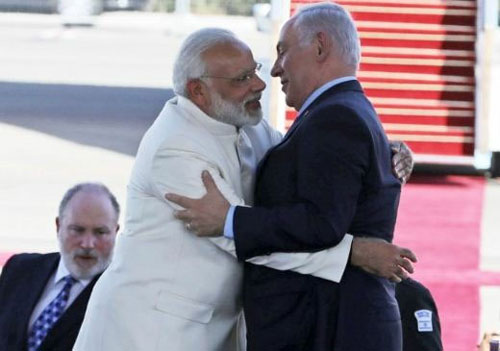Gaza
Israel has faced global condemnation for its actions in occupied East Jerusalem and continued bombing of the Gaza Strip, but it has found support in India where pro-government activists have thrown their weight behind Israel, with some defending its policy against Palestinians.
Hashtags such as #ISupport Israel, #India WithIsrael, #IndiaStands With Israel and #Isreal UnderFire have trended on Indian social media over the past week, many calling Palestinians “terrorists” – a term used by Israel for Palestinian resistance groups.
On Saturday night, #PalestineTerrorists was one of the top trends on Twitter in the South Asian nation.
At least 212 Palestinians, including 61 children, have been killed and more than 1,000 others wounded in one week of intense Israeli air attacks in besieged Gaza – home to 2 million people.
In the occupied West Bank, Israeli forces have killed at least 19 Palestinians protesting against the forced expulsion of Palestinian families from their homes.
At least 10 Israelis have also been killed in rockets fired by Hamas fighters from Gaza. During the past week, Israeli incursions into the Al-Aqsa Mosque compound and raids on the occupied East Jerusalem neighbourhood Sheikh Jarrah continued, while a brutal Israeli military offensive on the blockaded Gaza Strip has left many Palestinians dead.
But an extraordinary phenomenon has also taken root inside Israel, where thousands of Palestinian citizens in towns, villages and so-called “mixed” cities have taken to the streets to assert their identity while living in a self-defined Jewish state.
“What is remarkable is that within ’48 [modern-day Israel, with reference to the 1948 declaration of the state], Palestinians who have long been ignored or deemed as ‘Israeli Arabs’ are once again restating powerfully that they are Palestinians,” said Layla Hallaq, a Palestinian activist based in Haifa.
Hallaq told Al Jazeera that the current demonstrations are “unprecedented” and characterised by a popular solidarity movement among Palestinians within Israel, the West Bank and Gaza Strip, as well as in the diaspora.
“Their protests are not only of solidarity, but one of a shared cause and mutual pain experienced by every Palestinian.”
Israeli forces detain a group of Palestinian citizens of Israel in the city of Lydd on May 13 [Ahmad Gharabli/AFP]
Making up about a fifth of Israel’s population, Palestinian citizens of Israel number approximately 1.6 million people today.
Unlike the majority of Palestinians, who were ethnically cleansed by Zionist paramilitaries before and during the creation of the State of Israel in 1948, these Palestinians are descendants of those who managed to remain in their towns and villages or were internally displaced.
They are sometimes referred to as “1948 Palestinians” in reference to their location within territory that was forcibly taken over to establish the Israeli state.
The territory is also described as being “within the Green Line”, in reference to the line demarcating Israel from the occupied Palestinian territories under its control.
Despite holding Israeli citizenship, rights groups have documented several dozen Israeli laws that discriminate against Palestinian citizens across a wide spectrum of issues, including education, housing, political participation and due process. They are treated as second- and third-class citizens.
Mass protests During the past week, Palestinian protests have taken place in towns and cities across Israel, from the Naqab (Negev) Desert in the south to Ramla, Yafa and Lydd (Lod in Hebrew) in the centre of the country, to the “Triangle” region and to Haifa and Nazareth in the north.
The demonstrators rallied in solidarity with Palestinian families in Sheikh Jarrah, who are facing imminent forced expulsion from their homes, and against the Israeli storming of the Al-Aqsa Mosque compound, which left hundreds of Palestinians wounded.
It is not the first time Palestinian citizens of Israel have protested against Israeli policies.
Play Video In 1976, six Palestinians were shot and killed for protesting Israeli mass land expropriation – an event that came to be known as Land Day and is commemorated annually on March 30.
In October 2000, 13 Palestinians were shot dead as they joined in the second Intifada, triggered by then-Israeli Prime Minister Ariel Sharon’s visit to the Al-Aqsa compound.
Still, Israel historically has pursued a policy of fragmentation of the Palestinian population under its control, both inside the country and in the occupied Palestinian territories, making sustained shows of solidarity between Palestinians in various parts of historic Palestine all the more difficult.
But experts have said the continuing protests inside Israel show how connected Palestinians really are.
“The recent events highlight not only the unity of the system of colonial oppression, but also the unity of Palestinian struggle,” Nimer Sultany, a reader of public law at the University of London’s School of Oriental and African Studies, told Al Jazeera.
“Like in previous rounds of protests, such as in October 2000, Palestinian protesters in 1948 areas showed in practice the necessity and practicality of an anti-colonial struggle.”
A picture shows burned cars and a rubbish container in the city of Lod on May 13 [Ahmad Gharabli/AFP] ‘Colonial objective’
Sultany said Israel’s policy of maintaining a Jewish majority within the Green Line is no different from its demographic engineering in the occupied West Bank and East Jerusalem, where it works to dispossess Palestinians from their lands and impose a Jewish presence instead.
“The colonial objective of maintaining ‘Jewish demographic control’ or ‘Jewish sovereignty’ and Judaising Palestine is the same in the West Bank and East Jerusalem as much as in the Naqab, al-Jalil (Galilee), the ‘mixed cities’, and the Triangle,” he said.
One example is the city of Lydd, a city about 25km from Tel Aviv, which has now become a flashpoint for protests.










